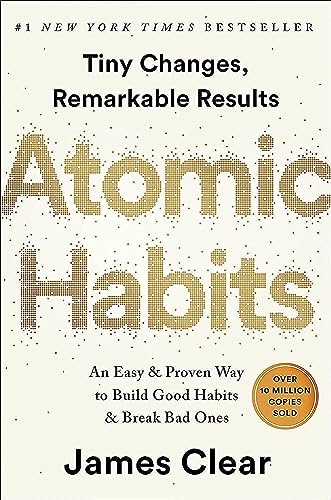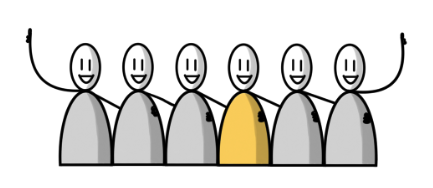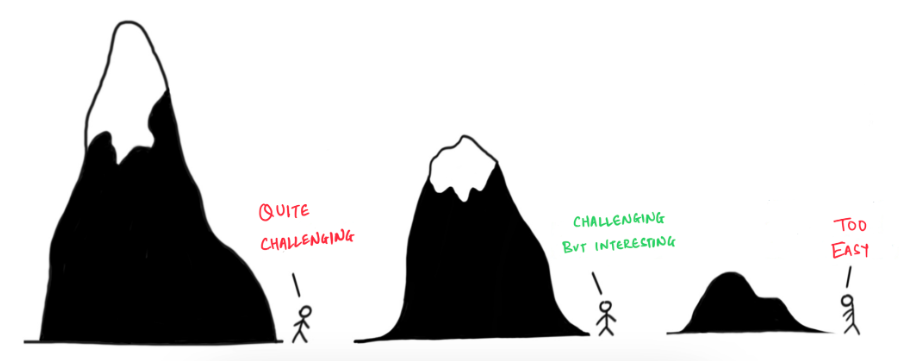Atomic Habits | James Clear
Published by getfundedeasily on
Atomic Habits by James Clears
This book has proven ways to build good habits and break bad ones. The author suggests that the key to making significant changes in life doesn’t have to involve major upheaval, i.e. we don’t need to revolutionise our behaviour or reinvent ourselves. Instead, we can make tiny changes to our behaviour which when repeated time and time again, will become habits that can lead to big results.

The fundamentals: Small habits make a big difference
- Habits are a compound interest of self improvement. Getting 1% better every day can make a huge difference in the long run.
- Goals are good for setting a direction, but systems aligned with the goal are best for making progress.
- If we want better results, do not focus only on goals, focus on building systems that are aligned to the goal and keep on improving the systems.
- Our outcomes are a lagging measure of your habits. For e.g. our current weight/fitness level is a lagging measure of our eating and exercising habits.
- The purpose of setting goals is to win the game. The purpose of building systems is to continue playing the game.
- We overestimate one defining moment, we convince ourselves that massive success requires massive action but we underestimate the importance of making continuous small and tiny improvements.
Habits shape our identity and our identity is shaped by habits.
The first chapter talks about the power of habits. The second chapter discusses how these habits are shaped. We generally look for a change in one of these three areas: outcome/results, processes, and identity. Outcomes are about what we get (I want to reduce weight to a certain number). Processes are about what we do (going to the gym and setting up the routine for nutritious food). And identity (I am a fit person) is about what we believe. Most of the time, we focus on what we want to achieve (I want to reduce weight to xx kgs) which is outcome-based behaviour. However, the author argues, we should focus on who we wish to become (I am a fit person). The more pride we have in a particular aspect of our identity, the more motivated we will be to maintain the habit associated with it.
The goal is not to read a book, the goal is to become a reader.
The goals is not to run a marathon, the goal is to become a runner.
The goal is not to learn an instrument, the goal is to become a musician.
Build better habits in four simple steps.
Habits reduce the level of activity in the brain. Habits are mental shortcuts learned from experience. For e.g. in managed services context, any system failure (害障) we have predefined series of steps that we meticulously follow, similarly once we develop a habit our brain creates a mental rule. This cognitive script can be followed automatically whenever the situation is appropriate. Many renowned leaders including Mark Zuckerberg wear the same dress everyday. Why do they do that? Our brain can only pay attention to one problem statement at a time. And the conscious mind is a bottleneck of the brain. Habits help reduce cognitive load and free up mental capacity so we can allocate our brain to more important work.
The process of building habit is divided into four stages
- Cue (you wake up)
- Craving you want to feel alert)
- Response (you drink a cup of coffee)
- Rewards (you satisfy your craving to feel alert, drinking coffee becomes associated with waking up).
The four laws of behaviour change: simple rules for creating good habits
- Cue – make it obvious
- Craving – make it attractive
- Response – make it easy
- Reward – make it satisfying
Bring more awareness in our habit and create a habit scorecard for our existing habits.
A human brain is a prediction machine. We can pick up the cues that predict a specific outcome without thinking about it. And our ability to notice the relevant cues/signals in a given situation is the foundation of every habit we have. We don’t need to see the cookies to realize we are hungry. Appetite and hunger are governed nonconsciously. To bring a behavioural change, we always need to start with awareness. We need to be aware of our habits before we can change them. The Japanese railway system is regarded as one of the best in the world. Do we know why? Because they use Pointing and calling system. Conductor and operator who runs the train go through a ritual of pointing to different objects and calling out commands. Pointing and calling raise our level of awareness from a non-conscious habit to a more conscious level by verbalising our actions. The habit scorecard (creating the list of daily habits we are aware of and scoring them based on effectiveness) is a simple exercise we can use to become more aware of our behaviour.
Two ways to start a new habit

Strategy we can use to pair a new habit with specific time and location.
Examples:-
- I will do pushups at 6am in the hall.
- I will read one chapter and summarize it at 6:30am at my desk
- I will make a tea at 8am in the kitchen
Strategy we can use to pair a new habit with a current habit.
Examples:-
- Before I drink my coffee, I will meditate for 2 minutes.
- After my imp meeting is over, I will immediately write and share the summary with the concerned team.
We are the architect for our lives.
The environment around is more imp than motivation. Set up the environment around us conducive to implementing our habits.
Key point: Make Cues easily accessible
- The most powerful sensory ability of human is vision… keep good things accessible easily such as gym dress, walking shoes, books you want to read, etc.
- Create location based habits, such as meditate at specific place, reading book at specific place, working at specific place, etc.
The secret to self control.
People with high self control tend to spend less time in tempting situations.
It is easier to avoid temptation than resist it.
Bad habits are autocatalytic the process feeds itself.

How to Make Habit Irresistible?
Use temptation bundling.
How to use temptation bundling in real life?
- After [CURRENT HABIT], I will [HABIT I NEED]
- After [HABIT I NEED], I will [HABIT I WANT]
Example: In my case, I want to do regular exercise, but right after waking up, I check emails… If I have to get rid of this habit, I can make a habit in this way.
- After I drink my coffee, I will do 20 minutes of exercise.
- After I do 20 minutes of exercise, I will check the emails.
Family, Friends and our role models shape our life.
“We are the average of the five people we spend the most time with.” – Jim Rohn.

Action:- Connect with people who will
- Appreciate your desired behaviour and positively challenge you.
- Help shape each other’s lives.
How to enjoy hard habits?
Hard habits will become attractive if we learn to associate them with a positive experience.
How to do it?
- Replace “I am nervous” with “I am excited and getting an adrenaline rush to help me concentrate”
- Replace “have’ with “get” e.g. I have to get to wake up early for work. I have to get to 10 sales calls everyday.
- Replace “I need to go run in the morning” with “It’s time to build endurance and get fast”
- Replace “I have to sell Rian licenses” with ”I got to help our clients go global fast and help increase their RoI ASAP”
Best is the enemy of good
- If we want to master a habit, the key is to focus on repetition, not perfection.
- With repetition, we should reach to a stage where our ability to perform behavior happens without thinking about each step.
How to make habits sustainable?
The simple answer is to make the habits effortless. Create a surrounding where implementing the right habit is as easy as possible. We naturally gravitate toward the least amount of work. Making things easy does not mean do easy things.
Examples:-
- If you want to read more then keep the book in front of you so that it is easily accessible.
- If you want to improve diet then keep fruits and vegetables QUICKLY accessible and junk food difficult to find.
How to stop procrastination?

The simple answer is to start small. Example:- if you want to run, focus only on 10 minutes of running. Once you ritualize this, very soon it will slip into the state of deep focus. Worry about optimizing the habit only after standardizing it.
How to lock into the habit?
Focus on Onetime Actions That Lock In Good Habits Look for onetime choices that require a little bit of effort up front but create increasing value over time.
Examples:-
- Nutrition: Use smaller plates to reduce caloric intake.
- Productivity: Delete games and social media.
- Focus: set your phone in Do Not Disturb mode when working
- Health: Buy better shoes to avoid back pain.
- Finance: Use systematic ways for investment such as SIPs.
How to make the habit repeatable?
Try to make the Habit satisfying. Find out ways to make the habit enjoyable. The key point is what is immediately rewarded is repeated. What is immediately punished is avoided.
How to make habit stick?
We need to feel immediately successful – even in a small way. Giving small rewards will increase the odds that a behaviour will be repeated next time. How to stick with the habit in the initial days? Simple answer is to track the habit The most satisfying feelings is the feeling of making progress. And to see the progress, create a habit tracker especially in the initial days.
Key points to remember
- This visual measurement shows evidence of your progress.
- Never break the chain.
- And don’t worry if you cant do it one day… get back on track ASAP.
How can we stop a bad habit?
Create habit painful or unsatisfying. Create an immediate consequence for the bad habit. If required, have an accountability partner for it.
Examples: –
- Customers who don’t pay on time charge them a late fee.
- If I overeat (binge eating), I will skip one meal the following day.
- If I take negative stress at work, I will set up a meeting and communicate my concern to the manager candidly the following day.
How to choose the right habit?
The secret to maximizing our odds of success is to choose the right area where our strengths are aligned. Be a great player: A good player works hard to win the game everyone else is playing. A great player plays a game that favours their strengths and avoids weakness. Find out what comes naturally to us where we get greater output than the average person.
“The Goldilocks Rule: How to Stay Motivated in Life and Work”.

The rule states that we experience peak motivation when working on tasks that are right at the edge on our current abilities. Not too hard. Not too easy. Just right.
Working hard when feeling motivated is normal. Extraordinary people work hard even when they are not motivated and stick with the schedule
How to achieve Mastery?
Habits + Deliberate practice = Mastery
The best part of habits is that we can do things without thinking. However, to be exceptional, we need additional nuanced approach. Deliberate practice involve remaining conscious of our performance over time and refine and improve by regular reflection and review.
Example: Cricketers need to do a lot of shadow practice as a part of their daily routine. Then only a deliberate practice help them bring their own cheeky shots in the game confidently.

Satisfaction = liking – wanting.
Being poor is not having too little, it is wanting more!